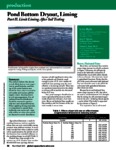Por favor, use este identificador para citar o enlazar este ítem:
http://www.alice.cnptia.embrapa.br/alice/handle/doc/1030649Registro completo de metadatos
| Campo DC | Valor | Lengua/Idioma |
|---|---|---|
| dc.contributor.author | LI, L. | pt_BR |
| dc.contributor.author | QUEIROZ, J. F. de | pt_BR |
| dc.contributor.author | BOYD, C. E. | pt_BR |
| dc.date.accessioned | 2015-12-04T11:11:11Z | pt_BR |
| dc.date.available | 2015-12-04T11:11:11Z | pt_BR |
| dc.date.created | 2015-12-04 | pt_BR |
| dc.date.issued | 2015 | pt_BR |
| dc.identifier.citation | Global Aquaculture Advocate, St. Louis, p. 36-37, Mar./Apr. 2015. | pt_BR |
| dc.identifier.uri | http://www.alice.cnptia.embrapa.br/alice/handle/doc/1030649 | pt_BR |
| dc.description | Abstract: The autors believe that dryout periods likely destroy most organisms in pond bettons, and liming of the entire botton area shoud be done only to neutralize soil acidity and increase pH for organic matter decomposition by soil microorganisms. Use of hydrated lime for disinfection should be reserved to particularly wet parts of pond bottons. When applying liming materials, it is important to spread them uniformly over moist soil - typically within two days after ponds are drained to assure dissolution. | pt_BR |
| dc.language.iso | eng | eng |
| dc.rights | openAccess | eng |
| dc.subject | PH Manejo do solo | pt_BR |
| dc.title | Pond bottom dryout, liming. Part II. Limit liming after soil testing. | pt_BR |
| dc.type | Artigo de periódico | pt_BR |
| dc.date.updated | 2016-01-25T11:11:11Z | pt_BR |
| dc.subject.thesagro | Lagoa | pt_BR |
| dc.subject.thesagro | Manejo de água | pt_BR |
| dc.subject.thesagro | Desinfecção | pt_BR |
| dc.subject.thesagro | Calagem | pt_BR |
| dc.subject.thesagro | Tanque | pt_BR |
| dc.subject.thesagro | Aquicultura | eng |
| dc.subject.nalthesaurus | Aquaculture | pt_BR |
| dc.subject.nalthesaurus | Liming | pt_BR |
| dc.subject.nalthesaurus | Soil management | pt_BR |
| dc.subject.nalthesaurus | Soil pH | pt_BR |
| dc.subject.nalthesaurus | Fish ponds | pt_BR |
| riaa.ainfo.id | 1030649 | pt_BR |
| riaa.ainfo.lastupdate | 2016-01-25 | pt_BR |
| dc.contributor.institution | LI LI, Shanghai Ocean University; JULIO FERRAZ DE QUEIROZ, CNPMA; CLAUDE E BOYD, Auburn University. | pt_BR |
| Aparece en las colecciones: | Artigo em periódico indexado (CNPMA)  | |
Ficheros en este ítem:
| Fichero | Descripción | Tamaño | Formato | |
|---|---|---|---|---|
| 2015AP02.pdf | 199.14 kB | Adobe PDF |  Visualizar/Abrir |









